Sometimes, less is more – especially when it comes to your CV. While traditional CVs give you two pages to showcase your experience, a one-page CV might be the way to go if you’re just getting a foot on the career ladder.
This guide, and 3 one-page CV examples will show you exactly how to condense your experience, skills, and qualifications into a clear, well-structured one-page CV that still gets interviews.
One page CV – Logistics
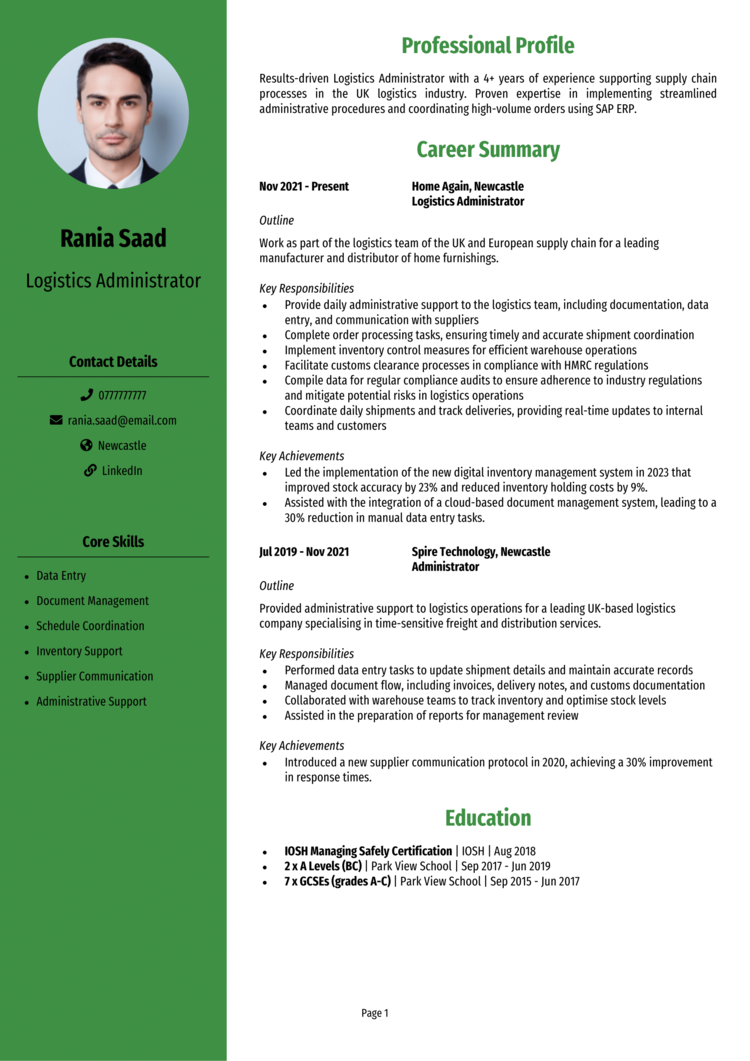
One page CV – Admin

One page CV – Receptionist
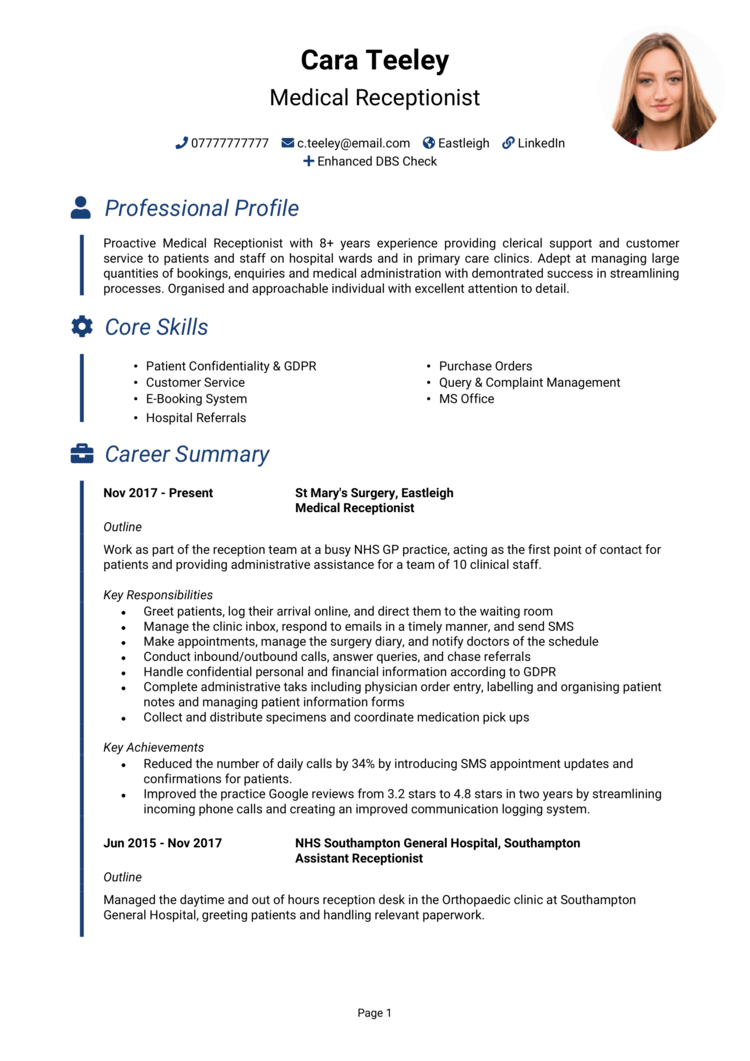
Should a CV be on one page?
A one-page CV is best suited for junior candidates, like recent graduates or school leavers, or just those with limited work experience. If you have several years of experience or a complex career history, a two-page CV is usually more effective. The key is to keep it concise while ensuring it includes all relevant details.
How to write your one-page CV
Learn how to create your own interview-winning one-page CV with this simple step-by-step guide.
A CV of just one page in length means only the essentials make the cut. It’s all about structuring your CV efficiently, prioritising the most relevant information, and making sure every word adds value.
In this guide, we’ll walk you through step-by-step writing a good CV which trims the fluff, highlights your best achievements, and structures your CV efficiently – so that even in a single page, you leave recruiters impressed.
How to fit a CV on one page
A one-page CV is all about keeping things concise, relevant, and well-structured. Here’s how to maximise space without losing impact:
- Use clear formatting – Tight spacing, professional font, and well-organised sections will keep things readable without wasting space.
- Trim older experience – Only include recent and relevant jobs. Combine similar roles or cut out early career positions.
- Keep your profile short – Briefly focus on your expertise and key strengths.
- Limit core skills – Pick just a few highly-important skills relevant to the role. No need for a long list.
- Condense work experience – Use bullet points to highlight key responsibilities and achievements in just a few points per job.
- Summarise education – Only include your highest or most relevant qualifications. No need to list school details if you have a degree.
Structuring your One-page CV


The layout of your one-page CV needs to be as streamlined as possible. Recruiters don’t have time to sift through unnecessary details, so your CV structure should help them find what they need at a glance.
Here’s how to structure your one-page CV efficiently:
- Name and contact details – Keep it simple: just your name, phone number, email, and optional LinkedIn. Including a picture of yourself is entirely optional, and only if it doesn’t take up space.
- Profile – A short summary of your expertise and career highlights, and the value you’d bring to companies that hire you..
- Core skills – Only list six essential skills at most that really match the job description.
- Work experience – List your most relevant roles in reverse chronological order, combining or trimming older positions.
- Education – Only mention your most recent and relevant qualifications and training.
- Additional info – If you’ve got the space, make a note of any relevant hobbies or awards that will back up your application.
Best format for a One-page CV
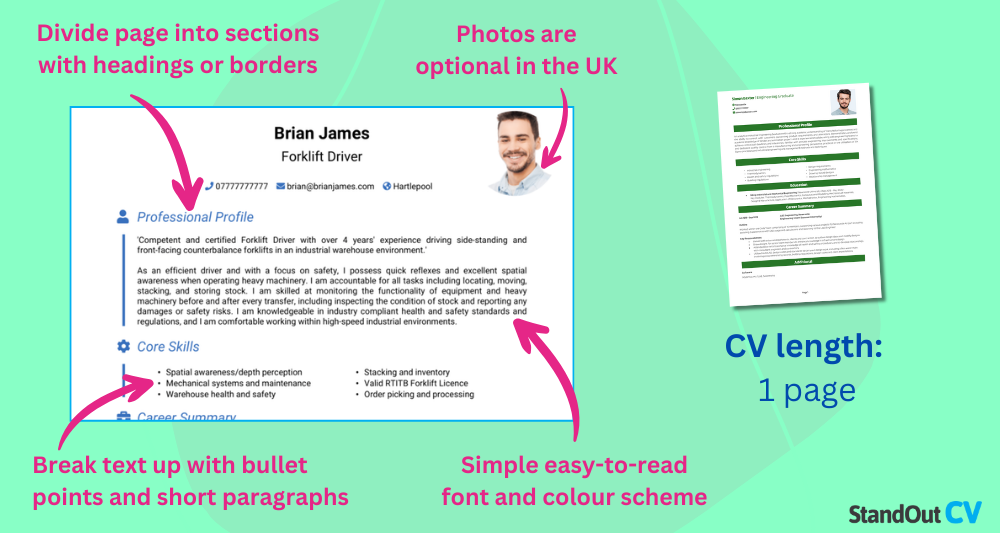
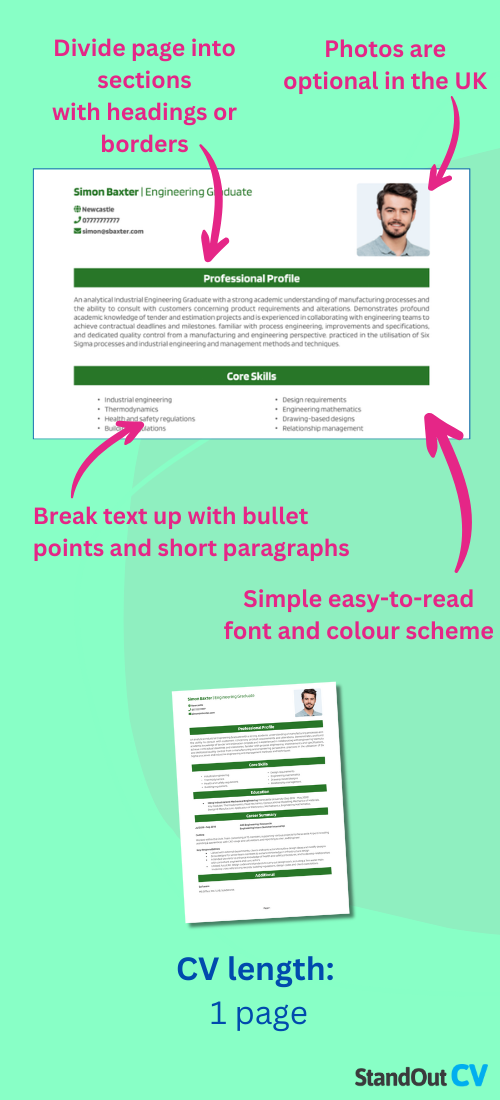
Writing a CV of any page count needs clear formatting, so recruiters can scan it quickly and get straight to the important details. A cluttered CV format is the fastest way to make sure your application gets overlooked – don’t make avoidable mistakes.
Here’s how to format your one-page CV for maximum impact:
- Bullet points – Keep details short and to the point to save space.
- Divide sections – Use clear headings in your CV to separate key information and improve readability.
- Opt for a clean font – Choose a professional, easily readable font with a compact but legible size – no smaller than 10pt.
- Use the ideal page formatting – Make the margins narrow and your line spacing smaller, to condense more information.
Creating your One-page CV profile


Your profile should be short, sharp, and straight to the point. In a one-page CV, there’s no room for long introductions – just a few line summary of what you bring to the table. Junior candidates should consider a slightly longer personal statement, or a cover letter if there’s more to say.
One-page CV profile examples
Profile 1
Enthusiastic Junior Marketing Assistant with a strong foundation in digital marketing, content creation, and social media management. Gained hands-on experience through internships and university projects, assisting with marketing campaigns, analysing audience engagement, and writing compelling copy. Proficient in tools like Google Analytics, Canva, and Hootsuite. Passionate about developing creative strategies to enhance brand awareness and drive customer engagement.
Profile 2
Detail-oriented IT Support Technician with a passion for troubleshooting and solving technical issues. Experienced in providing first-line IT support, setting up hardware and software, and assisting users with system-related queries. Skilled in Windows, macOS, and networking fundamentals, with hands-on experience using ticketing systems like ServiceNow. Committed to delivering excellent customer service and ensuring efficient IT operations.
What to include in your One-page CV profile
Here are some tips on how to write a concise, effective CV profile:
- Your industry experience – Mention your years of experience and relevant industries in one sentence.
- Top skills – Highlight your most relevant abilities without over-explaining.
- Biggest career highlight – Briefly mention a key achievement, like a project success or an award.
- The value you’ll bring – The whole point is to sell yourself and convince recruiters to hire you, so tell them what benefit taking you on board would have for them.
Core skills section


Your core CV skills section needs to be lean and focused. In a one-page CV, there’s no need for a long list – just go for no more than 6 skills that match the job description.
Instead of listing generic soft skills, focus on technical or job-specific abilities. For example, instead of saying “strong communication,” say “client relationship management“ – it’s more specific, and every bullet point counts.
Finding it hard to condense your CV into a single page?
Try our CV builder – it helps you streamline your experience with structured templates, concise pre-written content, and expert formatting tips.
Work experience
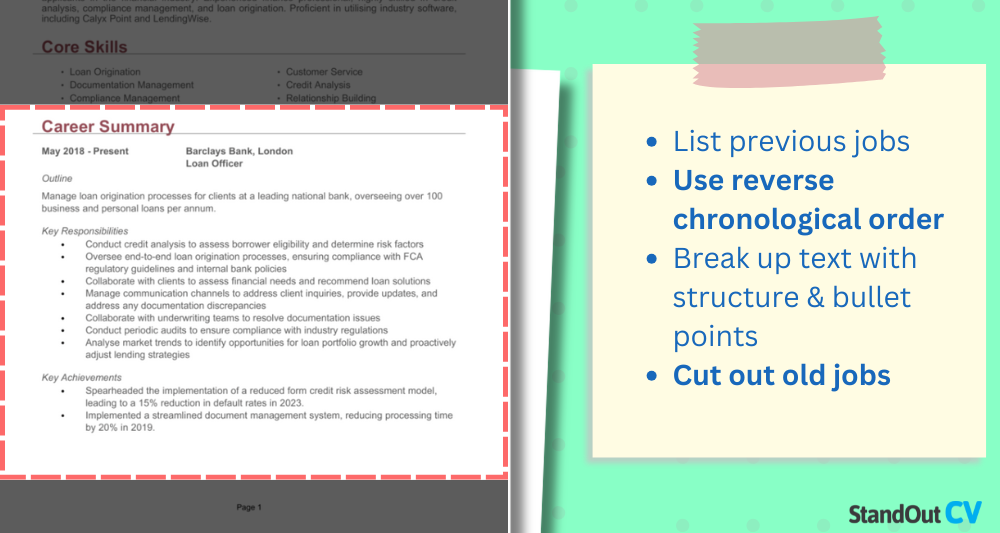
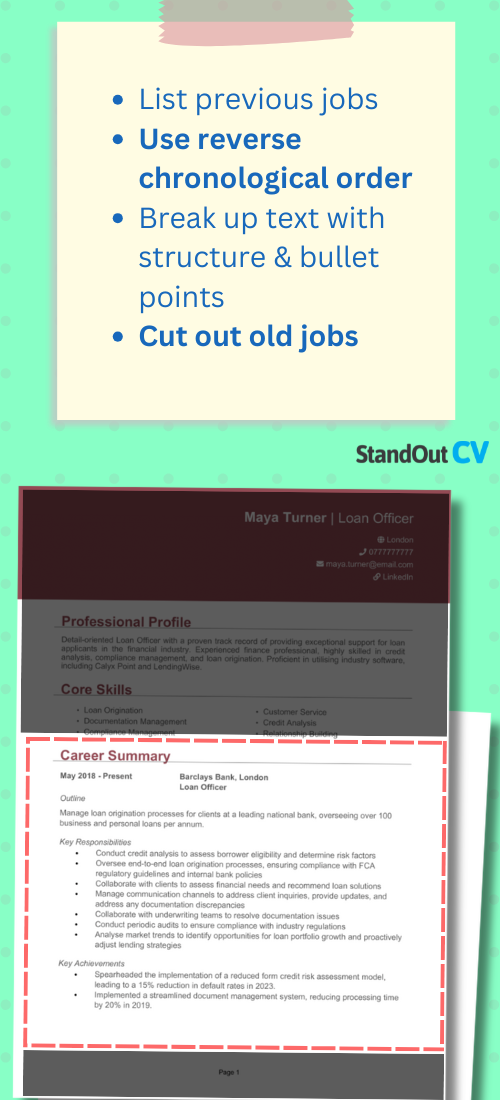
Your work experience section needs to be selective and concise. In a one-page CV, every job you list should be directly relevant to the role you’re applying for.
Here’s how to save space while still highlighting your experience:
- Only include the most relevant jobs – If you’ve had a long career, cut out older, less relevant roles.
- Shorten old roles – Old and less relevant roles don’t need to be outlined in depth – just state the title and dates.
- Combine similar positions – If you’ve had multiple roles at the same company, or very similar old, junior roles, group them together under one heading.
- Keep bullet points short – Stick to absolutely no more than 8 key responsibilities per role – and make sure not to repeat yourself.
- Remove unnecessary details – No need to list every responsibility – just the most impactful ones.
- Leave out references – Recruiters generally won’t contact your referees at this early stage, so there’s no need to include them.
Formatting your job history for your CV

- Outline – One or two sentences about the company and your role within it. For example: “Led a marketing team at a global tech firm, managing campaigns across multiple regions.”
- Responsibilities – Stick to your most important and impressive key duties, ensuring you don’t repeat yourself across jobs.
- Achievements – Use numbers where possible to quantify results and make them more impressive and tangible (e.g. “Increased client retention by 20% through targeted engagement strategies.”).
Example jobs for a one-page CV
Junior Marketing Assistant | ABC
Outline
Supported the marketing team in executing campaigns, creating digital content, and analysing audience engagement to improve brand visibility.
Responsibilities
- Assisted in managing social media accounts, scheduling posts, and engaging with followers.
- Created blog content, email newsletters, and promotional materials for marketing campaigns.
- Analysed website traffic and social media performance using Google Analytics and reporting tools.
- Conducted market research to identify industry trends and opportunities.
Achievements
- Increased social media engagement by 30 percent through targeted content strategies.
- Helped improve email open rates by 15 percent by refining subject lines and content structure.
IT Support Technician | ABC
Outline
Provided first-line IT support to internal users, troubleshooting technical issues and ensuring seamless system functionality across the organisation.
Responsibilities
- Responded to helpdesk queries, diagnosing and resolving hardware, software, and network issues.
- Installed and configured operating systems, applications, and security updates on company devices.
- Set up new employee workstations, including laptops, phones, and access credentials.
- Maintained documentation of IT procedures and troubleshooting guides for internal reference.
Achievements
- Resolved 90 percent of helpdesk tickets on first contact, reducing downtime for employees.
How to list your educational history


For a one-page CV, only include essential education details. Recruiters don’t need you to break down those GCSEs from decades ago – just the most relevant qualifications to the roles you’re going for.
Here’s how to keep your education section short and relevant:
- Only list your highest qualifications – No need to mention secondary school if you have a degree.
- Skip dates if space is tight – If you’re tight on space, just list the qualification without dates.
- Include relevant certifications – If they’re highly relevant to the job, mention them briefly.





